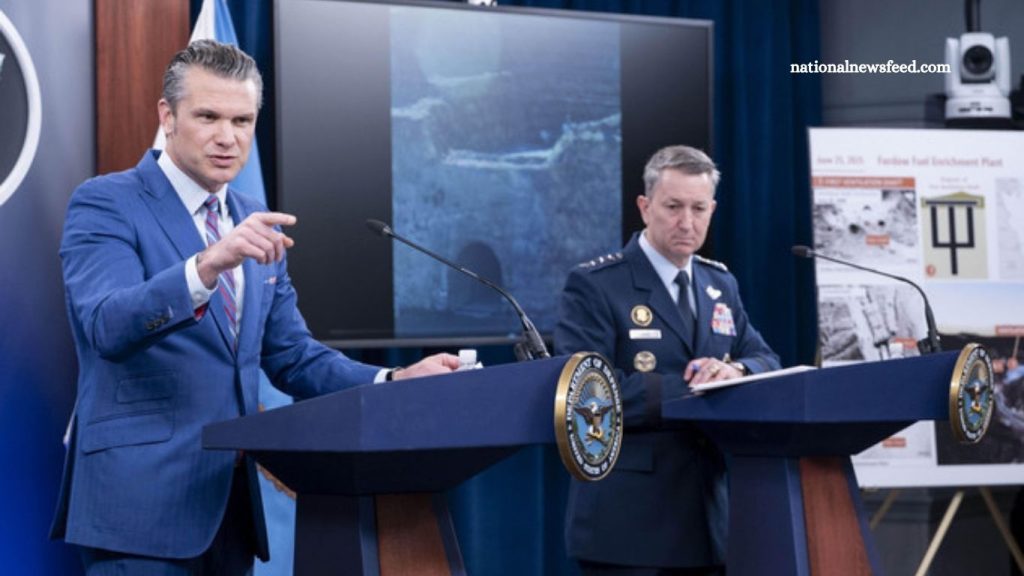The Trump administration faces growing skepticism over its bold claims that recent U.S. airstrikes have “obliterated” Iran’s nuclear program. Despite aggressive messaging and high-profile briefings, the government has yet to offer clear, verifiable evidence supporting these assertions.
Mounting Doubts After Leaked Intelligence Report
Trouble began when a preliminary, classified U.S. intelligence assessment leaked to the press. Contrary to President Trump’s declarations, the report suggested the strikes likely set Iran’s nuclear capabilities back only a few months—not decades, as claimed.
In response, administration officials launched a public relations campaign. Within 36 hours, top aides held press conferences, released statements from intelligence leaders, and attempted to reframe the strike as a long-planned military success.
Read More: Senate GOP Faces Setback on Medicaid Cuts in Megabill
The “Too-Early-to-Tell” Dilemma
Officials have paradoxically argued it’s too early to assess the full impact of the strikes—while simultaneously declaring them a historic victory. Defense Secretary Pete Hegseth emphasized that the Defense Intelligence Agency’s report was “low confidence” and prepared just 36 hours after the operation.
Nevertheless, during the same press conference, Hegseth claimed the attacks had “decimated” Iran’s nuclear infrastructure, an assertion many experts believe is premature without months of intelligence gathering.
Experts Demand More Concrete Proof
Nuclear experts and intelligence analysts argue that determining the full extent of damage requires satellite imagery, human intelligence, and access to Iran’s facilities—data not yet available. Complicating matters further, Iran’s parliament recently voted to suspend cooperation with the International Atomic Energy Agency (IAEA), making independent verification nearly impossible.
Questions Over Iran’s Uranium Stockpile
While the Trump administration focused on key nuclear facilities at Fordo, Natanz, and Isfahan, many believe Iran still possesses enriched uranium and spare centrifuges capable of restarting weapons development.
Satellite images taken prior to the attacks revealed truck convoys at targeted sites, raising concerns that vital materials were removed in advance. Yet when pressed, Hegseth and White House spokesperson Karoline Leavitt denied any intelligence indicating the movement of enriched uranium—though they failed to produce compelling proof.
A Nuclear Program Beyond Three Facilities
President Trump stated publicly that Iran’s nuclear capability was destroyed and claimed the program had been set back “decades.” But many experts and officials—both domestic and international—question whether three destroyed facilities represent the entirety of Iran’s program.
Some analysts believe Tehran may operate secret nuclear sites beyond the reach of the U.S. airstrikes. While Israeli intelligence efforts have eliminated many Iranian scientists over the years, the regime likely retains enough knowledge and resources to rebuild, if it chooses to.
Cautious Optimism from Intelligence Chiefs
Statements from key intelligence officials stopped short of endorsing Trump’s boldest claims. CIA Director John Ratcliffe described the facilities as “destroyed,” while Director of National Intelligence Tulsi Gabbard said rebuilding them would take “years.” Still, neither confirmed the complete dismantlement of Iran’s nuclear program.
Even staunch Republican allies in the Senate have tempered their praise. “Have we obliterated their desire to have a nuclear weapon?” Senator Lindsey Graham asked, suggesting intentions matter as much as infrastructure.
Conflicting Definitions of Success
The administration has subtly shifted its message. While initially focused on nuclear destruction, officials now point to a broader definition of success—namely, a ceasefire between Iran and Israel, and a potential path back to diplomacy.
Defense Secretary Hegseth cited the ceasefire as evidence of strategic victory: “Because of decisive military action, President Trump created the conditions to end the war.”
Unanswered Questions in Upcoming Talks
President Trump recently hinted at reopening negotiations with Iran, suggesting a willingness to move beyond the current impasse. However, if his administration truly believes Iran’s program is dismantled, many wonder why secret sites, uranium stockpiles, and enrichment capabilities still matter.
As pressure mounts to validate their claims, Trump officials will likely need to present stronger evidence—or shift their messaging once again.
Frequently Asked Questions
Did the U.S. airstrikes completely destroy Iran’s nuclear program?
No conclusive public evidence supports this claim. Officials say the strikes were effective, but independent analysts believe the impact may be limited.
What sites were targeted in the airstrikes?
The U.S. targeted nuclear facilities at Fordo, Natanz, and Isfahan—key sites in Iran’s uranium enrichment and fuel production.
Did Iran move nuclear materials before the strike?
There are suspicions Iran smuggled out materials beforehand, but the U.S. has not confirmed this with credible intelligence.
What does the leaked intelligence report say?
The preliminary report from the DIA suggests Iran’s nuclear program may have only been set back by a few months—not destroyed.
Why can’t more evidence be provided right now?
Full damage assessments require time, imagery, human intelligence, and access to the sites—all of which are currently limited or unavailable.
How has Iran responded diplomatically?
Iran’s parliament voted to suspend cooperation with the IAEA, hindering international verification efforts.
Is there any international consensus on the damage?
No. While U.S. officials claim success, agencies like the IAEA and independent analysts have yet to confirm the extent of the damage.
Will the U.S. pursue further negotiations with Iran?
Yes, President Trump has indicated openness to restarting talks, though the future of diplomacy remains uncertain.
Conclusion
The Trump administration’s narrative surrounding the Iran strikes is under increasing scrutiny. Despite confident statements from senior officials and dramatic language from the president, hard evidence is lacking. Independent verification will take time, and Iran’s resistance to outside inspection makes matters worse.
Until more data emerges, the administration’s declarations may remain more political than factual. Whether this becomes a turning point in Middle East diplomacy—or a misstep in messaging—depends on what unfolds in the weeks ahead.

